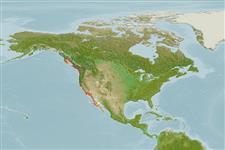Environment: milieu / climate zone / depth range / distribution range
Écologie
marin; saumâtre démersal; profondeur 0 - 2 m (Ref. 96339). Subtropical; 55°N - 22°N, 136°W - 111°W
Eastern Pacific: Rivers Inlet, British Columbia, Canada to Baja California, Mexico.
Taille / Poids / Âge
Maturity: Lm ? range ? - 3.4 cm
Max length : 6.4 cm SL mâle / non sexé; (Ref. 27436); common length : 4.2 cm TL mâle / non sexé; (Ref. 12193); âge max. reporté: 3.00 années (Ref. 72494)
Épines dorsales (Total): 4 - 5; Rayons mous dorsaux (Total): 15-17; Épines anales 0; Rayons mous anaux: 14 - 17. Caudal rounded.
Inhabits sand or mud bottom. Retreats into shrimp burrows when threatened and at low tide (Ref. 6885). Commonly in estuaries, lagoons and tidal sloughs. Reported to occur in freshwater. Adults feeds on diatoms, green algae, tintinnids, eggs and young of their hosts (Ref. 6885). Positions large food particles near crabs to be torn to smaller pieces (Ref. 6885). Preyed upon by Sebastes, staghorn sculpin, whitespot greenling, and terns (Ref. 6885). Unlike other gobies, it does not build a nest or care for its young (Ref. 2850).
Eschmeyer, W.N., E.S. Herald and H. Hammann, 1983. A field guide to Pacific coast fishes of North America. Boston (MA, USA): Houghton Mifflin Company. xii+336 p. (Ref. 2850)
Statut dans la liste rouge de l'IUCN (Ref. 130435)
Menace pour l'homme
Harmless
Utilisations par l'homme
Aquarium: Aquariums publics
Plus d'informations
RéférencesAquacultureProfil d'aquacultureSouchesGénétiqueElectrophoresesHéritabilitéPathologiesTraitementNutrientsMass conversion
Outils
Articles particuliers
Télécharger en XML
Sources Internet
Estimates based on models
Preferred temperature (Ref.
123201): 9.4 - 18.5, mean 10.8 °C (based on 189 cells).
Phylogenetic diversity index (Ref.
82804): PD
50 = 1.0000 [Uniqueness, from 0.5 = low to 2.0 = high].
Bayesian length-weight: a=0.00977 (0.00442 - 0.02163), b=3.05 (2.86 - 3.24), in cm total length, based on LWR estimates for this (Sub)family-body shape (Ref.
93245).
Niveau trophique (Ref.
69278): 3.1 ±0.42 se; based on food items.
Résilience (Ref.
120179): Haut, temps minimum de doublement de population inférieur à 15 mois (tm=1; tmax=2.5).
Fishing Vulnerability (Ref.
59153): Low vulnerability (10 of 100).
